Nicole schreibt...
Mecklenburg-Vorpommern July 2004 |
 |
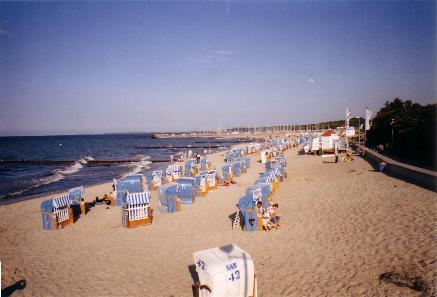 Asia... Australia... America... why not check out your own country as well? A holiday in Germany is all the rage at present for a mix of reasons and the most popular region is the Baltic Sea coast in Mecklenburg-Vorpommern stretching all the way from the Hanseatic town of Wismar in the west to the Polish border at Swinemünde in the east. It was this area rich towsnpeople from the then glorius capital Berlin and elsewhere in Prussa visited for their long summer holidays in 19th century and onwards.
After world war two the region became part of the communist German Democratic Republic and the regime left most of the former seaside resorts to crumble and decay. A holiday at the seaside was very much discouraged for they feared that people might attempt to escape the socialist paradise across the sea (thousands did and many died trying). After reunion the seaside towns sprang to new life and have been refurbished, so along with most of my countrymen
I wanted to check the area out.
First stop was Kühlungsborn, a nice little seaside town west of Rostock and much cheaper than oh-so-fashionable Warnemünde a few kilometres further up the coast. The drawback of a holiday in Germany is of course that the places are full of... well, Germans. Why my countrymen are quite so devoid of a sense of humour and incapable to manage welcoming smiles in hotels and restaurants I guess I shall never figure out. It was pleasant enough anyway.
Asia... Australia... America... why not check out your own country as well? A holiday in Germany is all the rage at present for a mix of reasons and the most popular region is the Baltic Sea coast in Mecklenburg-Vorpommern stretching all the way from the Hanseatic town of Wismar in the west to the Polish border at Swinemünde in the east. It was this area rich towsnpeople from the then glorius capital Berlin and elsewhere in Prussa visited for their long summer holidays in 19th century and onwards.
After world war two the region became part of the communist German Democratic Republic and the regime left most of the former seaside resorts to crumble and decay. A holiday at the seaside was very much discouraged for they feared that people might attempt to escape the socialist paradise across the sea (thousands did and many died trying). After reunion the seaside towns sprang to new life and have been refurbished, so along with most of my countrymen
I wanted to check the area out.
First stop was Kühlungsborn, a nice little seaside town west of Rostock and much cheaper than oh-so-fashionable Warnemünde a few kilometres further up the coast. The drawback of a holiday in Germany is of course that the places are full of... well, Germans. Why my countrymen are quite so devoid of a sense of humour and incapable to manage welcoming smiles in hotels and restaurants I guess I shall never figure out. It was pleasant enough anyway.
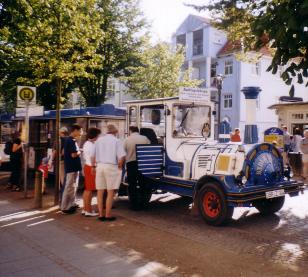
|
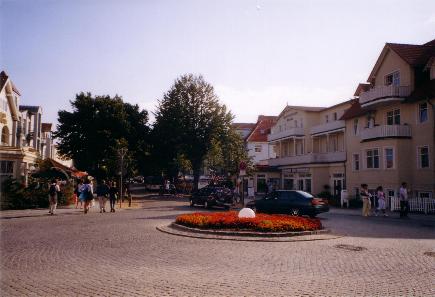 |
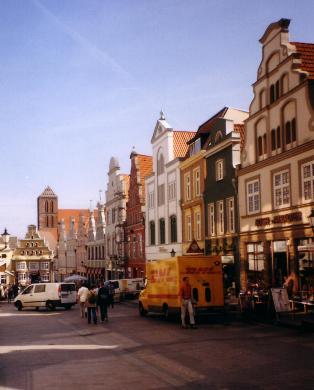 Kühlungsborn was of course only the centre of operations and the first excursion took me to Wismar, which was officially Swedish until 1903. The town centre looks like a miniature Prague full of lovely ancient houses and could well serve as a movie set for historic films and mini series. Since the weather was great in the morning (certainly not the standard for this area), we hurried back to Kühlungsborn and the beach, but after half an hour sunbathing it started to cloud over and get rainy.
Kühlungsborn was of course only the centre of operations and the first excursion took me to Wismar, which was officially Swedish until 1903. The town centre looks like a miniature Prague full of lovely ancient houses and could well serve as a movie set for historic films and mini series. Since the weather was great in the morning (certainly not the standard for this area), we hurried back to Kühlungsborn and the beach, but after half an hour sunbathing it started to cloud over and get rainy.
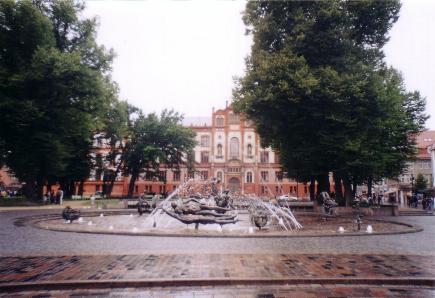 So we headed for Rostock, which is not the capital of Mecklenburg-Vorpommern as many think (that's Schwerin), but the biggest most-important town on the coast. It's a nice airy place full of ancient houses again. Below is the university with its "lust for life"-fountain. Unfortunately lust for life had deserted me by then as it was pissing it down in buckets now and I headed for the cinema instead to watch Spiderman 2.
Next stop was the island of Rügen, Germany's biggest island at the North-Eastern tip of the country. To get there, you have to go through Stralsund, another lovely Hanseatic town (and a fabulous skyline to behold when you cross the long bridge to Rügen). Below is Stralsund's Marienkirche (St.Mary's) to the left and the town hall and St.Nikolai (St.Nicholas) to the right:
So we headed for Rostock, which is not the capital of Mecklenburg-Vorpommern as many think (that's Schwerin), but the biggest most-important town on the coast. It's a nice airy place full of ancient houses again. Below is the university with its "lust for life"-fountain. Unfortunately lust for life had deserted me by then as it was pissing it down in buckets now and I headed for the cinema instead to watch Spiderman 2.
Next stop was the island of Rügen, Germany's biggest island at the North-Eastern tip of the country. To get there, you have to go through Stralsund, another lovely Hanseatic town (and a fabulous skyline to behold when you cross the long bridge to Rügen). Below is Stralsund's Marienkirche (St.Mary's) to the left and the town hall and St.Nikolai (St.Nicholas) to the right:
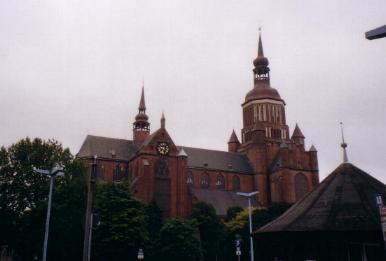
|
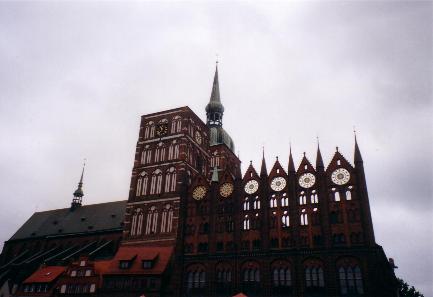 |
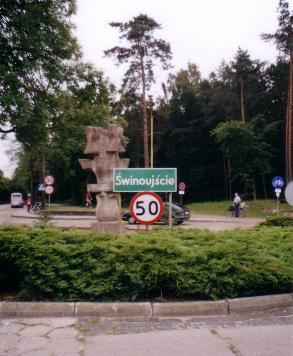 On Thursday we decided spontaneously to pay our eastern neighbours in Poland a flying visit. German-Polish relations have always been difficult andPoland and its citizens have often been the target of cheap jokes over here. I cannot deny that Poland ranks very low on the list of countries I'm keen on visiting, but nonetheless here we were in Swinemünde (Swinoujscie) on the island of Usedom, whose eastern part was handed over to Poland after the war, while the western part remained German. Hundreds of Germans cross the border every day, though not to visit the town. We didn't make it there either for just across the border is a huge flea market where you can get cheap cigarettes, fake designer labels and pirated CDs and DVDs for a few Euros. So we pottered around there for an hour, then decided to head back to Germany.
On Thursday we decided spontaneously to pay our eastern neighbours in Poland a flying visit. German-Polish relations have always been difficult andPoland and its citizens have often been the target of cheap jokes over here. I cannot deny that Poland ranks very low on the list of countries I'm keen on visiting, but nonetheless here we were in Swinemünde (Swinoujscie) on the island of Usedom, whose eastern part was handed over to Poland after the war, while the western part remained German. Hundreds of Germans cross the border every day, though not to visit the town. We didn't make it there either for just across the border is a huge flea market where you can get cheap cigarettes, fake designer labels and pirated CDs and DVDs for a few Euros. So we pottered around there for an hour, then decided to head back to Germany.
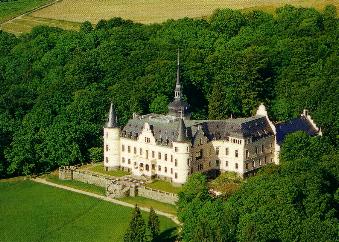 The main reason for the whole venture up north-east were actually the Störtebeker Festspiele at Ralswiek on Rügen island. Every summer Germany's most famous pirate Klaus Störtebeker sails again at the huge open air venue that offers horses, carriages and cannonballs on stage and real ships doing sea battles at sea on the Jasmunder Bodden. We decided to stay at pretty Ralswiek Castle for this, as it was only recently converted into a nice and surprisingly cheap hotel and overlooked the open air stage. While we couldn't actually follow the show from the castle for a second time, we did see the fireworks that end each performance.
The main reason for the whole venture up north-east were actually the Störtebeker Festspiele at Ralswiek on Rügen island. Every summer Germany's most famous pirate Klaus Störtebeker sails again at the huge open air venue that offers horses, carriages and cannonballs on stage and real ships doing sea battles at sea on the Jasmunder Bodden. We decided to stay at pretty Ralswiek Castle for this, as it was only recently converted into a nice and surprisingly cheap hotel and overlooked the open air stage. While we couldn't actually follow the show from the castle for a second time, we did see the fireworks that end each performance.
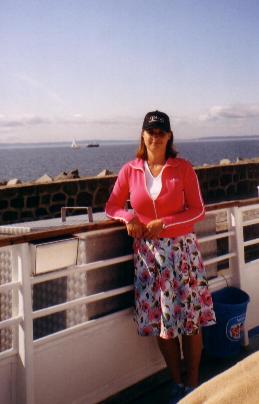 On Friday we finally went to visit Rügen's most interesting places, such as the white cliffs of... no, not Dover ;) This is the eastern coast of Rügen with white cliffs stretching from Sassnitz further north. The most famous cliff is the Königsstuhl (King's Seat) and many people walk the three miles from the car park to the actual Königsstuhl, but I thought it would be much more comfortable to watch the coastline from a little ship. So here's also a photo of yours truly aboard :) And below the beautiful coastline and the little port of Sassnitz where the tourist boats depart:
On Friday we finally went to visit Rügen's most interesting places, such as the white cliffs of... no, not Dover ;) This is the eastern coast of Rügen with white cliffs stretching from Sassnitz further north. The most famous cliff is the Königsstuhl (King's Seat) and many people walk the three miles from the car park to the actual Königsstuhl, but I thought it would be much more comfortable to watch the coastline from a little ship. So here's also a photo of yours truly aboard :) And below the beautiful coastline and the little port of Sassnitz where the tourist boats depart:
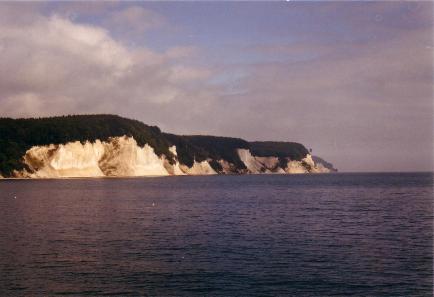
|
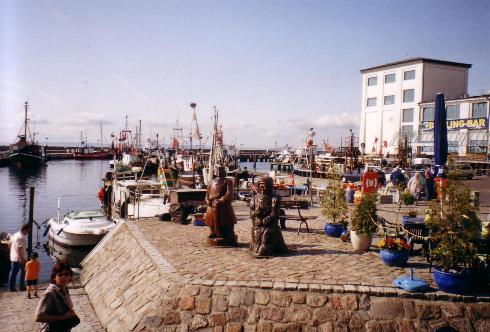 |
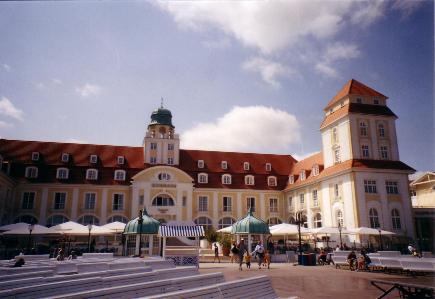
|
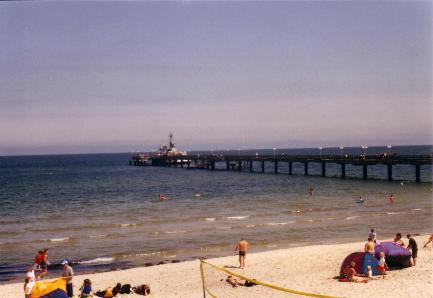 |
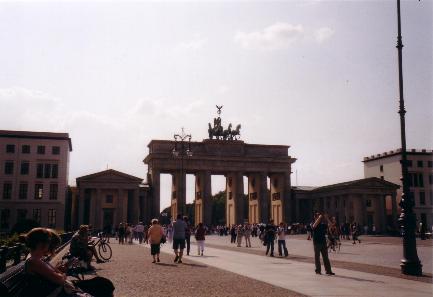
|
 |
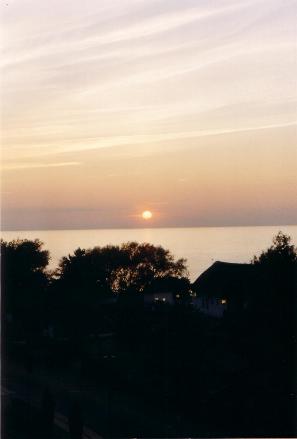 Overall it was a very enjoyable trip and a discovery of many nice places along the coast. Especially the old Hanseatic towns with their well-preserved old towns are worth a visit, while the weather is just too unpredictable to plan a seaside holiday (unless you don't mind swimming in ice-cold water while a strong wind is blowing - many people were nuts enough to do that, but for the first time in ages I didn't manage to get deeper into the water than up to my knees because it was just too cold.
Overall it was a very enjoyable trip and a discovery of many nice places along the coast. Especially the old Hanseatic towns with their well-preserved old towns are worth a visit, while the weather is just too unpredictable to plan a seaside holiday (unless you don't mind swimming in ice-cold water while a strong wind is blowing - many people were nuts enough to do that, but for the first time in ages I didn't manage to get deeper into the water than up to my knees because it was just too cold.
Copyright © All Rights Reserved